You want to become a tattoo artist, but don’t know where to start. Aren’t you lucky for stumbling across this article, because today we’re going over the first step to get you started on this rollercoaster of a journey.
Building a rock-solid portfolio filled with your best artwork is the most crucial step you’ll need to take in order to make a good impression and get yourself an apprenticeship. Here’s how to do so.
Table of Contents
Why a physical portfolio is a necessity
Even if you have amazing artwork uploaded online, it wont (always) cut it. You’ll need a physical portfolio if you want to get anywhere. So, don’t go looking for an apprenticeship if all you can show is an online portfolio.
Why? Because going in with a physical portfolio shows that you have taken the time and effort into building it up. It shows that you take pride in your work and know about the unwritten rules (although, now written). If you can’t be bothered to make one, then it’s more likely you wont last that long as an apprentice.
Just make one and take your time with it. It will show your potential mentors that you’re serious about this and you’ll come across as a professional.

A physical portfolio also allow you to show different materials used (paint, color pencil, graphite pencil, watercolor, ..). Which emphasizes your versatility.
When you are targeting a long distance studio, and you prefer to send a digital portfolio therefor, then at least make a nice PDF, instead of just linking your IG. A PDF can include more then just photo’s like you post them online. It can contain close-ups to see your cleanliness, it can combine text, info about you as a person, like mixed with a CV.
About the artwork
Now that we understand why you need a professional portfolio, we have to know what most tattoo shops and tattoo artists are looking for.
In short, less is more and the presentation matters. Let’s get more detailed.
Less is more
Or with other words, quality over quantity! Every successful tattoo artist will confirm this.
It’s better to have a few (10 to 20) great, finished pieces to showcase instead of 30 half-a**ed drawings. This shows that you have the required patience to finish an artwork and being patient will definitely come in handy for your apprenticeship.
A full sketchbook can be a great addition to this limited quality portfolio. There it’s more about quantity, and it shows that you are trying this for a long time, and doing little pieces every day. So while your sketchbook is not showing the best quantity finished pieces, it can show your endurance and your ‘way of life’.
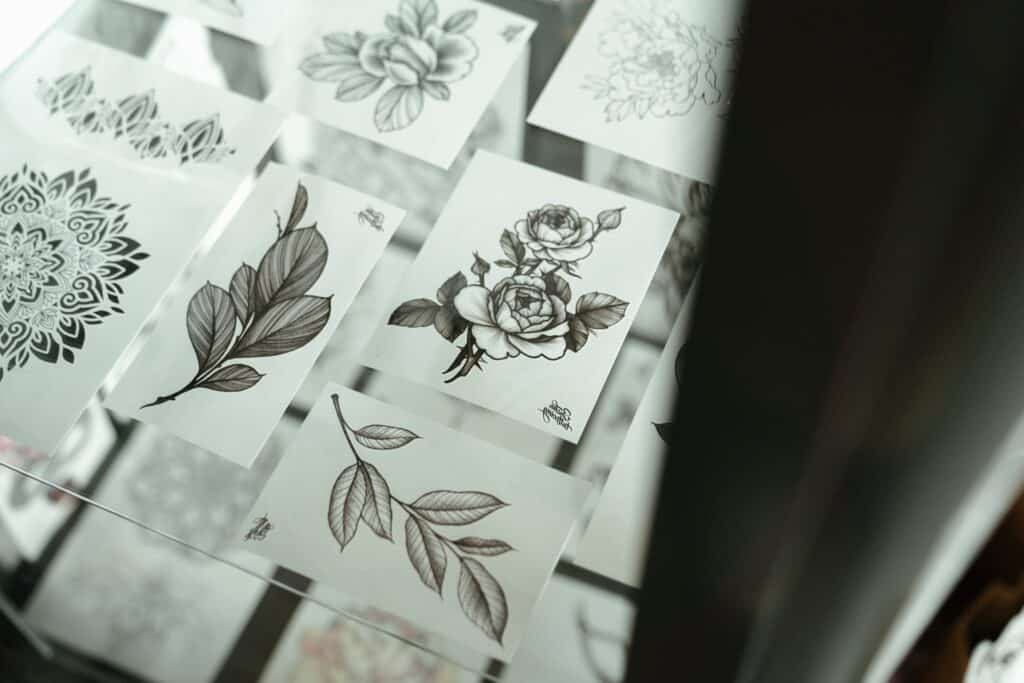
Being the best version of yourself
If we think about it more, the more time and effort we put into something we love doing, the better it is. So, not only will you have epic pieces to show, but you’ll also indirectly let the tattoo artist know that you’re really dedicated into being the best artist you possibly can!
The look of a high-quality artwork
There are a few things tattoo artists look for when going over the pieces a potential apprentice shows them.
First, are your sketchy lines gone?
Make sure you erase the pencil markings you made, unless it’s a pencil drawing, of course.
Third, shading on point?
Whichever shading technique you prefer, try to the best of your abilities to perfect it.
Study about the light sources, where the shadows need to come. Ask yourself the question: where is my (imaginary) lamp?
And last but not least, consistency
Being consistent with the chosen techniques for all of the above will help with getting an overall cleaner look.
Don’t start crosshatching and then randomly switch up to dotwork. There’s a way of doing everything and if you want to combine techniques, there’s also a way for that.
But remember, art doesn’t have rules, (or does it?) so experiment and you’ll figure out what works for you!
Second, are your lines straight?
Being able to pull clean lines is an absolute must if you want to become an established artist in the tattoo industry. Make sure you’ve done your best to perfect your linework.
Don’t leave crossed lines, make sure all of the intersections are smooth. When coming to an end of a line, make them all the same sharpness. Dont have random sharp-end and round-end lines.
Fourth, do you color in like a toddler?
When coloring in large areas, you need to ensure you actually color them in.
Don’t leave random empty spots or lighter areas where it needs to be the same shade and just stay within the lines!
Take your time with everything and be patient with yourself. That’s the only way you’ll be able to avoid these mistakes.
Solid colored pieces are proof of your capability of patience.
What to incorporate: versatility
Once you’ve got the fundamentals down, it’s time to put them to use. When and if it’s your time to start tattooing, you’ll have to be able to design everything in order to satisfy your clients.
This requires the skill of being a versatile artist, meaning, you’ll have to include different tattoo styles in your tattoo apprenticeship portfolio.
Including versatile pieces will not only showcase your artistic abilities, but it shows your potential mentor that you’ve taken the time to study the different tattoo styles. It expresses your interest in tattooing culture and history.
Research about the tattooing styles
Some must do’s are American traditional, tribal, Japanese, neo-traditional, realism, mandala’s and script. These are different styles that are prominent in the tattoo world.
Include both color and grayscale pieces
Make sure you study color theory as you’ll need it for color tattoos. Black and gray, needless to say, is also a necessity to master.
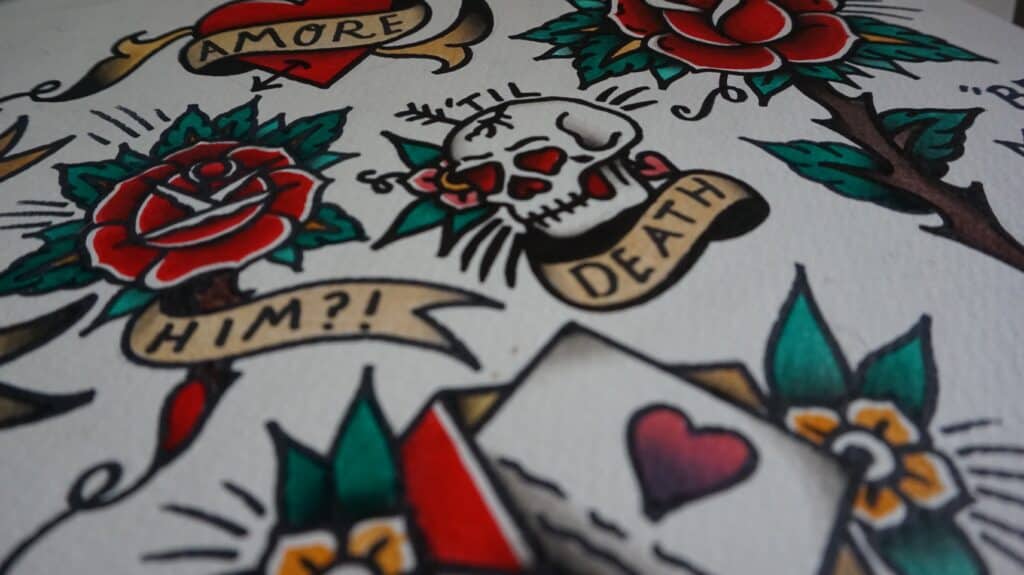
Just don’t forget that showing your own artistic style is also very important, as it will show the tattoo artist a piece of your personality.
For potential apprentices that already have a very distinct own drawing style of a pretty descent level: a specilised portfolio can also be a way to go, instead of the well versatiled one.
Presentation
When presenting your portfolio, it’s true that keeping it clean and professional might be a good idea, HOWEVER, if you really want to slap some stickers on it, just do it! The right people will be able to look past it and if your work speaks for itself, it shouldn’t matter. If you want to be safe, do it on the inside of the cover. It’s a side of you, don’t hide it.
Staying true to yourself will automatically attract the same people in your life and push away those who don’t match with your values. This is a good thing when getting started.
Some tattoo artists say that they don’t even need to see a professional black folder as long as the work in there is clean. Other artists find it important, because it shows a work ethic and the professional manner they’re looking for in an apprentice.
Decide for yourself, but we think that keeping it clean might make the road a bit easier.
The different art media and which ones you should use
An art medium is basically the art supply used in order to create an artwork, such as the type of paper, type of pencils/paints, etc…
While sticking with one medium only can help with the overall cleanliness of the portfolio, switching it up might not be a bad idea.
In our opinion, the more different ones you use, the better. If you can add some pencil drawings, marker drawing, digital/physical paintings, etc… that’d make a great portfolio!
This would showcase, once again, versatility and artistic abilities. Just don’t forget to add tattoo art aswell.
Choosing your mentor
Not everyone will have the luxury or opportunity to choose their mentor or tattoo shop they’d apprentice in, but if you do, there’s a few things you might want to keep in mind.
It’s important to remember that your teacher, is who you’ll become later on. Your surroundings are also very important! Let’s take the example of regular high-school.
High-school has an educative system teachers must follow. If and when there’s a kid that needs more accommodations that school is, more often than not, likely to turn a blind eye and enforce learning methods that just don’t work for that kid. Whether it’s a kid that has a certain diagnosis or not.
Not everyone learns the same way
If you haven’t reflected on this before, let’s think about it together. A learning/teaching method that works for one student, will not work for another. This is why some students learn better with visuals, while others need to have something explained in detail multiple times until they see the logic. If a teacher is unable to provide flexibility of their methods, school becomes harder and frustrating for that kid.
The same goes when it comes to apprenticeships. Lots of, mainly old-school, tattoo mentors aren’t open to new approaches. It’s their way or the highway. This works for some, but not all.
It’s true that you should listen to a mentor and do what they tell you to do, but that doesn’t mean you can’t have your own opinion and that you have to be their slave. There should be mutual respect AND understanding.
Things to look out for, red flags
The first thing you might want to look out for is, literally, their vibe. Do they give out a negative or a positive vibe?
Be observative, analyse their behaviour. It’s perfectly fine if a person is more quiet and a bit intimidating, this does not mean they’re a negative person.
Focus on the way they do and say things. An example: do they put a lot of effort into everything even if it goes unnoticed? What about their words?
You can learn A LOT about a person by simply listening to the way they word things. Do they blame unsuccesses on external factors, or do they acknowledge their own mistakes and things they can do better in the future?
How do they speak about their colleagues? Are they really nice face to face, only to talk trash behind their back? Or are they straight up non-bullsh*tters? Having someone who says what they mean and mean what they say, will do you much better than having a double-faced rat as a boss/mentor.
If you get a negative impression, just ask them about the thing you’re worried. Just don’t come off as cocky or arrogant. Show them you just want to understand and be humble.
The second thing, how is their communication towards you?
Good communication, from both sides, is essential in the tattoo business. Even more so, when you’re just getting into it.
You might be good at communicating, but, are they? Do they just let you make mistakes only to blame you for them afterwards? It’s okay to make a few mistakes, but if they plain out see you doing something you’re absolutely not supposed to and they don’t approach you…
Keep in mind: Beggars can’t be choosers. While all this info about choosing a great mentor is interesting, It’s most of all you who have to make a good student to your mentor.
Be humble, appreciative, honest, very hard working, clean, and stand for the studio you work in. It’s most often the mentor who has to pick you, not vice versa.
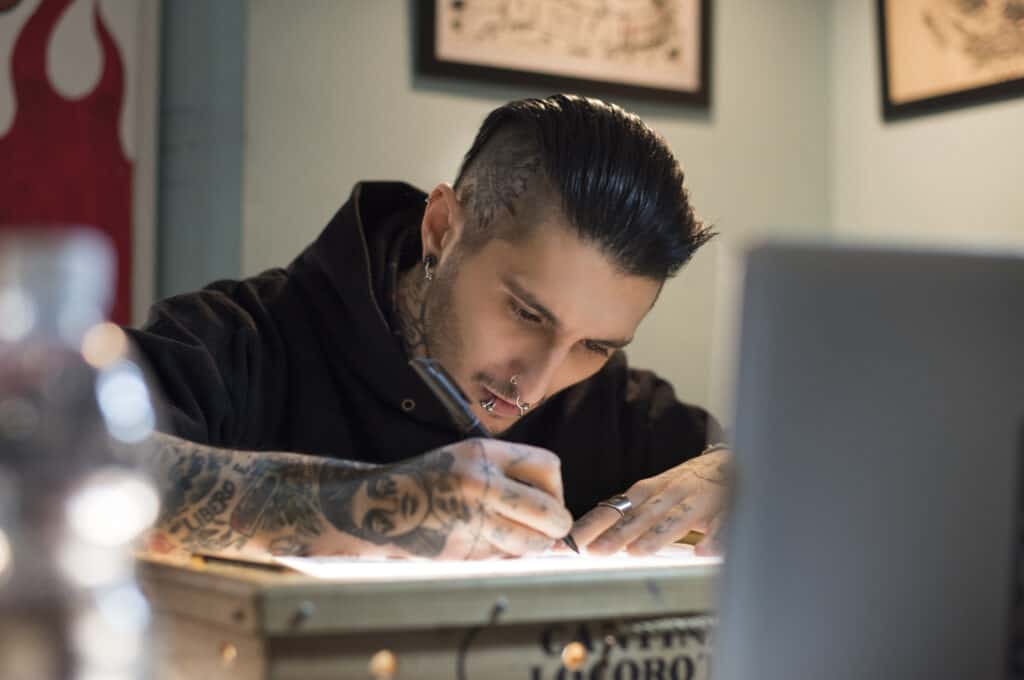
Extra tips
Know your goals
Before getting an apprenticeship, you should have a rough plan sketched out in your mind for the future. Do you want to learn just how to tattoo?
Or are you dreaming of your own tattoo shop one day? If you want to create a tattoo business yourself one day, you might want to put extra effort into learning more behind the business side. If they let you, that is.
Others, want to learn about everything there possibly is to learn. So, keep it in mind. Communicate your wants early, in order to get the opportunities later on. Just don’t expect it to be all handed to you in your hands.
Some studio’s like apprentices who want their own business, some studio’s prefer artists who are not into that. Be as transparent as possible, even if you didn’t make up your mind about these things yet.
Put your creative ideas on a personal website
Even if your studio has a website and there’s a gallery page where you have your own page, still put in the effort to make your own.
Social media is great, sure, but what if Instagram randomly decides to ban you because of a silly comment? All of your work would be gone and your killer portfolio you’ve built up online… Poof, vanished within seconds.
Having your own professional website is perfect for ensuring that, if something were to happen in the shop or to your social media accounts, you wouldn’t be left with nothing.
Plus, google traffic is more benificial than you’d think.
If you don't have your own style yet, try out already existing tattoo styles
By trying out already existing tattoo styles, you’ll not only understand it, but you’ll be able to use an element from it to build up your own style. Put your own unique spin on it and see what happens.
E.g. tribal designs, instead of filling them all in black, do them in a color or multiple colors! U might even try to do a ‘realistic’ tribal piece.
Besides putting flash sheets and artwork in, include your CV
Make a few copies of your CV and include them in your portfolio. When you go around shops, you can leave your CV behind if anyone’s interested.
If you get positive feedback, but they can’t offer you an apprenticeship, because e.g. there isn’t any place, still leave one. You never know what might come out of it.
If you're still in high-school and are intersted in art education - do it.
Although art education isn’t for all, if you have the opportunity, take it. Even if you know your goal career is to be a professional tattoo artist someday. An art education might make your life so much easier!
Just keep in mind the cons. If you really feel like it’s something you want and need to do, however, just go for it. Even in the worst case scenario, you’ll survive.
Don't put in unfinished work on your portfolio
You might come off as sloppy and lazy.
FAQ
An impressive portfolio is one that stands out from the rest. Good sense of flash pages with tattoo designs in different styles, at least one full page of your unique style and maybe some intricate lettering – should be a good start.
If you’re a digital artist, be sure you have good image quality when printing.
This can be both a positive and a negative thing. Most tattoo artists see this as being too lazy to stop by their shop.
On the other hand, it’s considerate from your side. If you show that you’re sending them an e-mail, because you know they’re busy people and want to respect their time – it might work out.
No, there’s plenty of other things you can do to simulate the experience of tattooing, like drawing with sharpies on someone or getting an electric dotting pen.
Not necessarily.
A tattoo style is an art style, but an art style isn’t always a tattoo style. Just try your best to figure out your personal art style, if you can’t figure out what you’d like to specialize in.
You’ll have to be able to do everything in the beginning, anyways.
The ones you’re best familiar with.

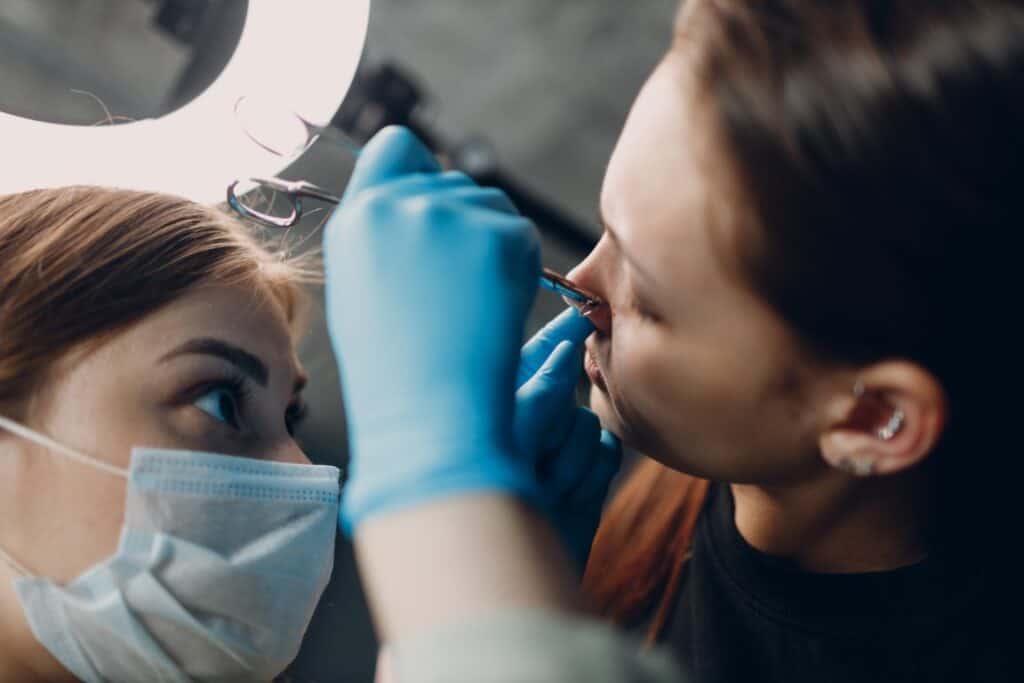
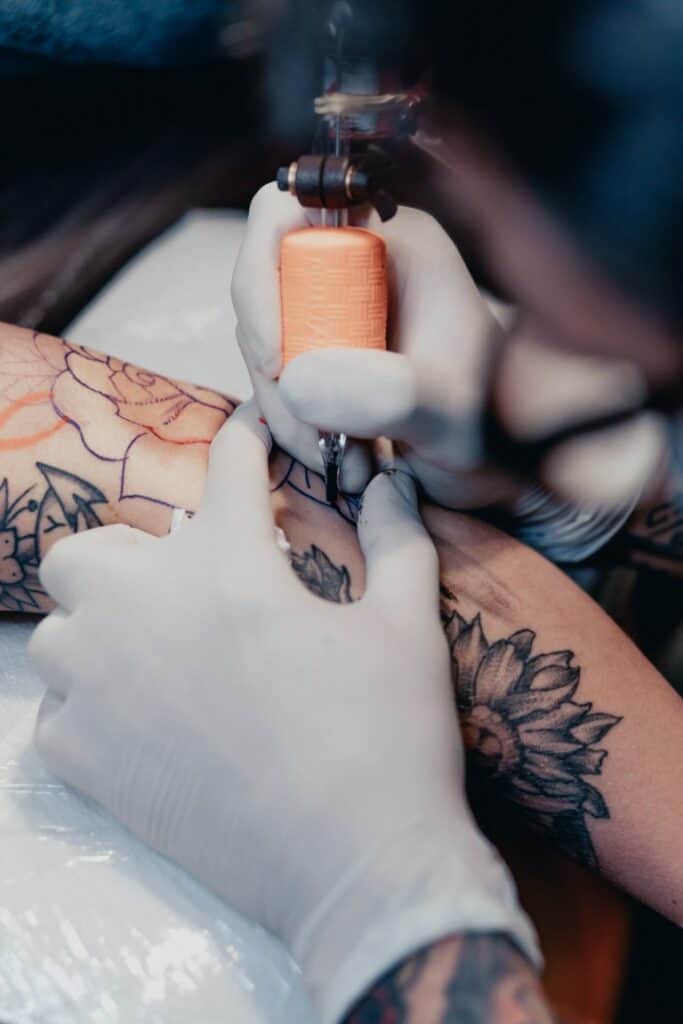
Pingback: When tattooing runs in your blood: interview with Dario Berrittella - tattoogenda.com
Pingback: Tattoo artist Tasha Wild talks about running a tattoo shop - tattoogenda.com